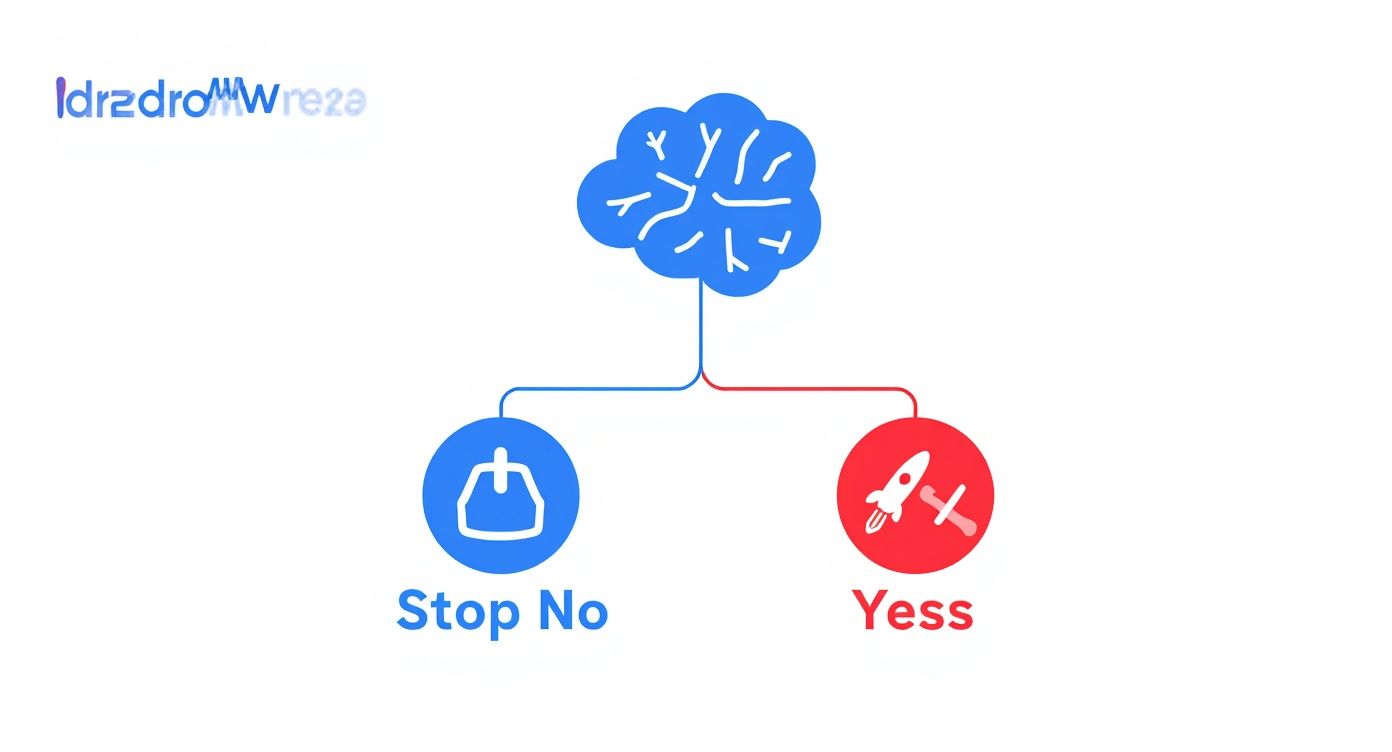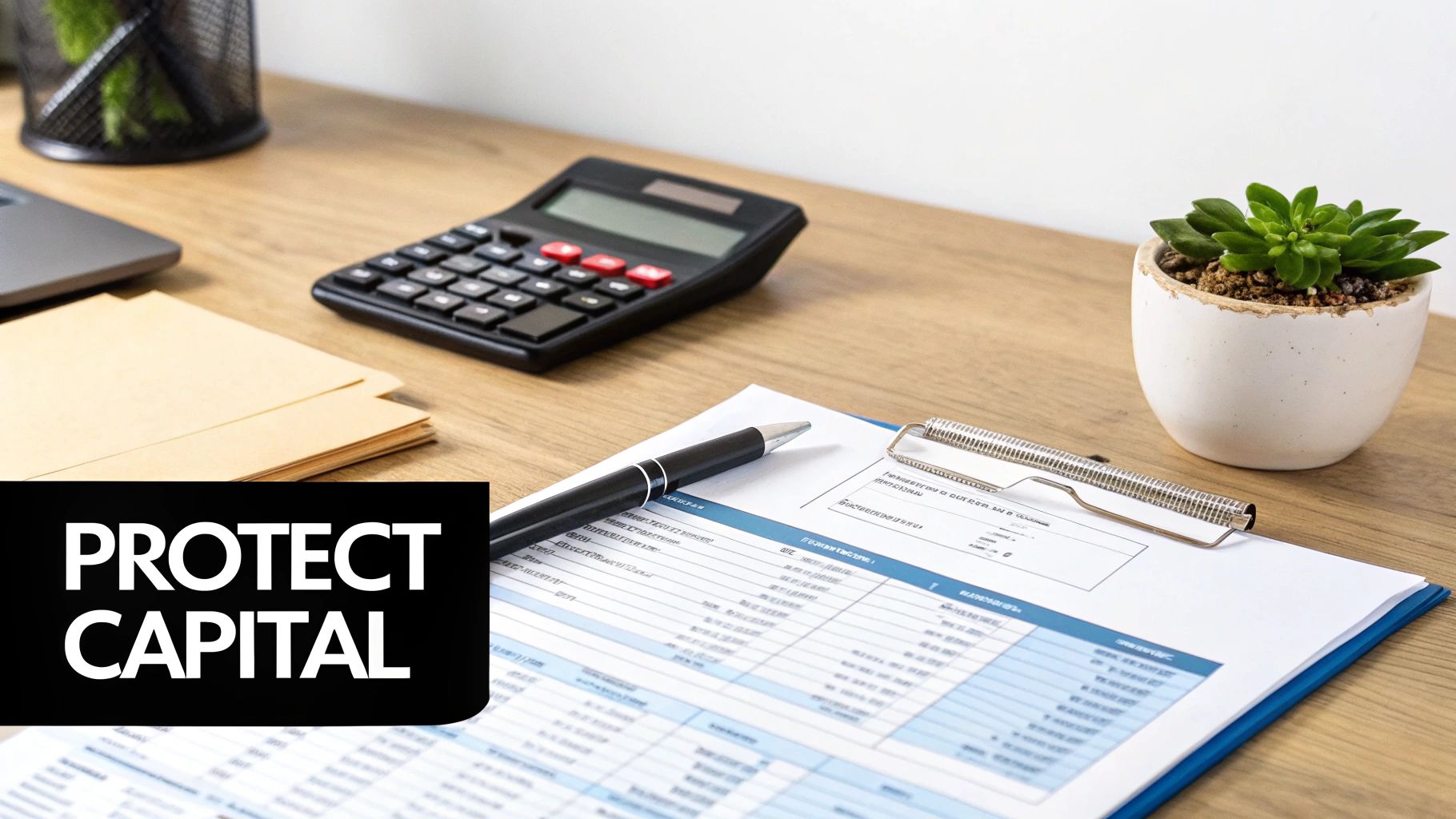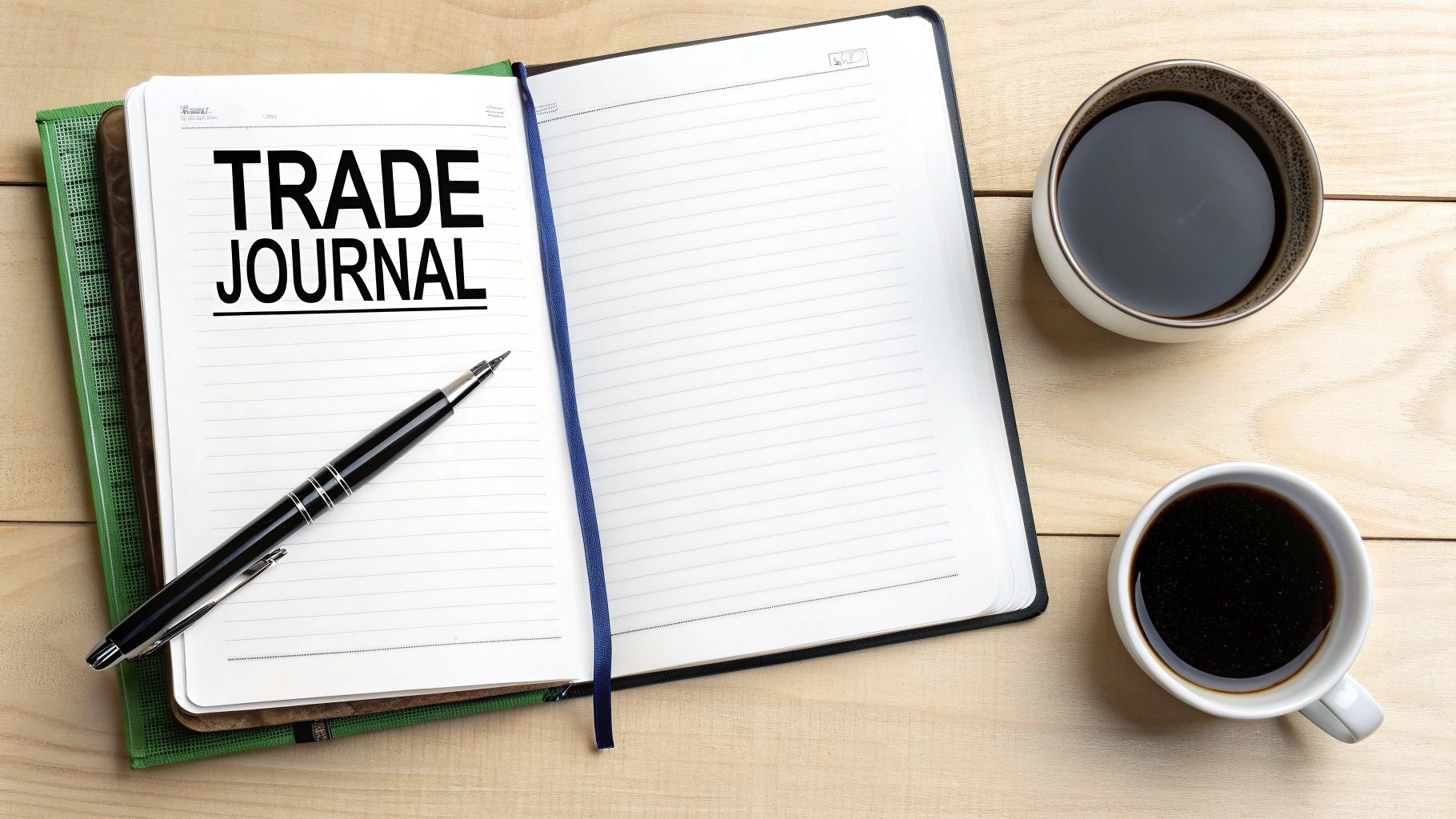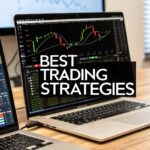Learning to trade futures isn’t about finding a magic formula. It’s a journey that demands a deep respect for how markets work, a disciplined mind, and an ironclad approach to managing risk. Think of it as building a skill over time — not chasing a lottery ticket. Lasting success is built on realistic goals, a rock-solid trading plan, and the habit of constantly reviewing your own performance.
Starting Your Futures Trading Journey the Right Way
Let’s be honest — diving into futures trading can feel like trying to drink from a firehose. You’re hit with a wall of jargon, fast-moving charts, and the very real possibility of big wins and even bigger losses. It’s an incredibly common story: an aspiring trader jumps in, full of hope, only to get humbled by the market’s raw complexity and their own emotional tripwires.
This guide is here to cut through all that noise. I’m not selling you on guaranteed profits or a “secret” indicator. My goal is to help you build a durable foundation, one that can support a long-term trading career. That means starting with the absolute basics and, just as importantly, confronting the psychological hurdles that knock out an estimated 90% of new traders.
What Is a Futures Contract, Really?
Before we even glance at a chart or talk strategy, let’s get clear on what you’re actually trading. A futures contract is just a standardized agreement to buy or sell something — like oil, corn, or a stock index — at a set price on a future date. It’s a tool that was originally created for producers and consumers to lock in prices and manage their business risk.
Here’s a practical scenario: Imagine a corn farmer who expects to harvest 10,000 bushels in three months. She’s worried the price might drop by then, crushing her profits. To protect herself, she can sell a futures contract today, locking in a sale price of, say, $5.00 per bushel.
On the other side of that trade, a massive food company like Kellogg’s might be worried prices will spike, increasing their costs. To stabilize their budget, they buy that same futures contract, agreeing to purchase the corn at $5.00 in three months. Both parties have just hedged their risk. As a retail trader, you’re speculating on the price movements between now and that future date, without ever having to deal with a single kernel of corn.
Before you go any further, it’s essential to get a handle on the core concepts. These aren’t just vocabulary words; they’re the building blocks of every single trade you’ll ever make.
Key Futures Trading Concepts at a Glance
| Concept | What It Really Means | Why It’s Critical |
|---|---|---|
| Leverage | You control a large position (e.g., $100,000 worth of an index) with a small amount of capital (margin). | Amplifies both gains and losses. It’s a double-edged sword that must be respected at all times. |
| Margin | The “good faith” deposit required to open a futures position. Think of it as collateral. | It’s not a down payment; it’s the capital you put up to cover potential losses. If your trade goes against you, you can lose more than this amount. |
| Tick Size | The minimum price fluctuation for a contract. For example, the E-mini S&P 500 moves in 0.25 point increments. | Every tick has a specific dollar value (e.g., $12.50 for the ES). Knowing this is key to calculating profit and loss. |
| Expiration | The date the contract becomes void and must be settled. | Most speculators close their positions well before this date to avoid physical delivery. |
| Contract Specs | The official rules of a contract (e.g., size, tick value, trading hours). | You absolutely have to know these before trading any product. No exceptions. They are the ‘rules of the game.’ |
Getting these basics down isn’t just a suggestion — it’s your first line of defense against costly rookie mistakes.
The Real Challenge Is Your Mindset
Getting the mechanics down is the easy part. The real battle in futures trading is fought between your ears. It’s that knot in your stomach right before you click “buy,” the wave of frustration after a loss, and the urge to chase a trade you just missed. We’ve all been there.
Your success as a trader won’t be defined by your best trades. It will be defined by how you handle your worst ones. A defensive, disciplined mindset is your single most valuable asset.
This is exactly where most new traders fall apart. They spend all their energy hunting for the perfect entry signal while completely ignoring the mental skills needed to execute their plan day in and day out, especially when things get tough. Success isn’t about being right all the time — it’s about having a system that protects you and keeps you in the game when you’re inevitably wrong.
Why Data Is Your Best Friend
A professional trader runs on data, not gut feelings. Building and testing a solid strategy requires a serious look at how the market has behaved in the past. This means digging into extensive historical market data, which can span decades across all sorts of global commodities and financial contracts.
For example, some data providers offer tick-by-tick intraday futures data going back to December 1974 for over 280 global contracts. This incredibly rich dataset, complete with price, volume, and even bid-ask quotes timestamped to the millisecond, is what allows pros to analyze market patterns with surgical precision. If you’re serious, you should explore the importance of historical futures data and see how it’s used to find a real edge.
This data-driven mindset pulls emotion and guesswork out of the equation. It lets you see exactly how your strategy would have performed through different market environments, giving you the confidence to stick to your rules — even when you’re in a drawdown. That’s the difference between gambling and professional speculation.
Choosing Your Broker and Mastering Your Platform
Think of your trading platform as your command center. It’s where you make every decision and take every action, so it’s not something to choose lightly. Before you even think about putting real money on the line, you need to get your hands on the right tools and know them inside and out. This isn’t just about finding the cheapest commissions; it’s about platform stability, quality data, and support that actually answers the phone when things go sideways.
Too many new traders get drawn in by flashy ads promising rock-bottom fees, only to learn the hard way that reliability is priceless. A platform that freezes during a fast market or a data feed that lags can turn a small, managed loss into a catastrophic one. When you’re in a trade, you need to have absolute confidence in your gear.
This decision tree nails the mindset you need before you even start shopping for a broker.

The bottom line? Getting your head in the right space is a non-negotiable first step. It comes before everything else.
What to Look for in a Futures Broker
When you’re comparing brokers, you have to look past the surface-level costs. A slightly higher commission is a tiny price to pay for a trading environment you can count on.
Here’s what really matters:
- Platform Stability: Does the platform have a reputation for crashing or lagging during high-volume events, like a major news release? A stable platform isn’t a “nice-to-have”; it’s essential.
- Data Feed Quality: Accurate and fast market data is the lifeblood of your trading. Make sure the broker provides a top-tier data feed straight from the exchange.
- Customer Support: When you have a problem with an open position, you need help now, not tomorrow. Test their support response times before you even fund an account. Can you get a real person on the phone quickly?
- Margin Requirements: Intraday margins vary a ton between brokers. Lower margins might look appealing, but they’re also a recipe for over-leveraging. You want to find a balance that fits a conservative approach to risk.
Picking the right partner from day one saves you a world of frustration later. To help you sort through the options, check out our detailed trading platform comparison that digs into the features of popular choices for futures traders.
Setting Up Your Trading Cockpit
Once you’ve picked your broker, it’s time to set up your platform. The goal is to create a clean, efficient, and distraction-free workspace that helps you execute your plan without a hitch.
Your initial setup should be all about simplicity. You don’t need a dozen blinking indicators and five different chart types. Start with a clean price chart, a volume indicator, and maybe one or two simple moving averages. The more cluttered your screen is, the more likely you are to get stuck in analysis paralysis.
The Non-Negotiable Step: Demo Trading
Every professional pilot logs hundreds of hours in a simulator before they ever fly a real plane. Trading is no different. Your demo account is your flight simulator, and using it is not optional when you’re learning the ropes.
A demo account isn’t for testing if you can make money; it’s for building the muscle memory to execute your plan perfectly without hesitation. It’s where you learn your platform, not the market.
You need to practice everything until it becomes second nature.
- Placing Orders: Get comfortable placing market orders, limit orders, and stop-loss orders.
- Managing Positions: Practice adjusting your stop-loss to breakeven or trailing it behind a winning trade.
- Executing Your Plan: Follow your rules to the letter, just like you would with real money.
The point of all this is to eliminate any fumbling with the software when real emotions and real capital are on the line. This deliberate practice builds the discipline you need to perform under pressure. Only after you can execute your plan flawlessly in a demo environment should you even consider trading with a small, live account.
How to Build Your First Trading Plan
Trying to trade the markets without a plan is like wandering into a blizzard with no map. You might get lucky, but chances are you’ll just end up lost, cold, and broke.
A trading plan isn’t some vague idea in your head. It’s a rock-solid set of rules that dictates every single move you make. It’s your business plan, your operations manual, and your emotional circuit breaker all rolled into one powerful document.
When the market is ripping and your heart is pounding, you don’t rise to the occasion — you fall back on your training. Your trading plan is that training, written down for when you need it most.
Finding a Style That Fits Your Life
Before you can even think about rules, you have to figure out what kind of trader you are. This isn’t about picking what’s “best” on paper; it’s about finding a style that genuinely fits your personality, your daily schedule, and how much stress you can handle. Forcing a style that doesn’t fit you is a one-way ticket to burnout.
Here are the three most common styles you’ll see in futures trading:
- Scalping: Scalpers are the sprinters of the trading world. They’re in and out of trades in seconds or minutes, trying to skim tiny profits off small price moves. This demands intense focus, razor-sharp execution, and the stomach to make dozens of high-pressure decisions. It’s not for the faint of heart.
- Day Trading: Day traders open and close all their positions within a single trading day. They never hold anything overnight. This takes a serious time commitment during market hours but frees you from the risk of some surprise overnight event wrecking your position.
- Swing Trading: Swing traders are looking for the bigger moves. They’ll hold positions for several days or even weeks to capture a larger “swing” in price. This style is way more flexible if you have a 9-to-5, but it requires a ton of patience and the discipline to sit tight through smaller price wiggles that go against you.
Building a Simple Trend-Following Plan
Alright, let’s get our hands dirty and build a simple, rules-based plan. We’ll focus on a liquid market like the E-mini S&P 500 (ES) futures. When you’re learning to trade futures, you want liquidity. It means tight spreads and the ability to get in and out of your trades without a fuss.
Contracts like the S&P 500 E-mini futures regularly trade hundreds of thousands of contracts a day, giving you plenty of opportunity. These markets are massive, with exchanges like the CME Group processing over 3 billion contracts annually. You can dig into the data on these active markets to see just how deep they are.
Our strategy is a basic trend-following system using moving averages. Let me be clear: this is a starting template, not some “guaranteed profit” machine. The goal is to show you what a rules-based approach actually looks like in practice.
The Strategy Components:
- Instrument: E-mini S&P 500 (ES)
- Timeframe: 5-minute chart
- Indicators: 9-period Exponential Moving Average (EMA) and 21-period EMA. (The EMA gives more weight to recent prices compared to a simple moving average).
- Setup: We’re looking for the market to establish a clear trend.
With these pieces, we can lay down the exact rules that will guide every trade.
A trading plan is a set of objective rules that removes your emotions from the decision-making process. If you have to ask yourself, “Should I get in now?” — your rules aren’t clear enough.
Defining Your Rules of Engagement
This is the heart of your plan. Every rule needs to be black and white, leaving zero room for you to second-guess yourself in the heat of the moment.
-
Entry Rule (Long):
- The 9 EMA must be above the 21 EMA (this shows us we’re in an uptrend).
- Price must pull back and touch the 21 EMA.
- Enter a long position only when a full candle closes above the 9 EMA after that touch.
-
Entry Rule (Short):
- The 9 EMA must be below the 21 EMA (our signal for a downtrend).
- Price must rally back up and touch the 21 EMA.
- Enter a short position only when a full candle closes below the 9 EMA after the touch.
These rules give you a precise trigger. There’s no guessing. No “gut feelings.” You just follow the checklist.
Planning Your Exit Strategy
Believe it or not, your exits are even more important than your entries. Pros are obsessed with managing risk and protecting their capital. That all starts with knowing exactly where you’re getting out before you even think about getting in.
- Stop-Loss Rule: Place your initial stop-loss just below the low of the signal candle for a long trade, or just above the high of the signal candle for a short trade. This is your absolute, non-negotiable eject button if the trade goes south.
- Profit Target Rule: Set a profit target at a risk/reward ratio of 1:2. So, if your stop-loss is 8 points away from your entry, your profit target is 16 points away. Simple.
And there you have it. This plan covers every critical part of a trade: the setup, the entry trigger, the risk-defining stop, and the profit target. This becomes your roadmap, and your only job is to follow it with unwavering discipline.
Mastering Risk Before You Master the Markets

Let’s get one thing straight. When you’re learning to trade futures, your most important job isn’t finding perfect entries or predicting the market’s next big move. Your number one role, above all else, is to be a risk manager.
Long-term survival in this game has almost nothing to do with how great your winning trades are. Seriously. Your entire career hinges on one thing: how effectively you contain your losers. This is all about playing defense, not offense, and it’s the single biggest skill separating the pros from the crowd.
The One Percent Rule: A Non-Negotiable Law
The most powerful rule you can live by is the 1% rule. The concept is brutally simple yet profoundly effective. You will never, under any circumstances, risk more than 1% of your total account equity on a single trade. This isn’t a suggestion; it’s an unbreakable law.
Let’s use a practical example. Say you have a $10,000 trading account. Your maximum loss on any one idea is $100. If your account grows to $12,000, your max risk climbs to $120. On the flip side, if you hit a rough patch and your account drops to $8,000, your risk must shrink to just $80 per trade.
This rule does two critical things. First, it makes it mathematically difficult for a single bad trade to cripple your account. You could be wrong ten times in a row and you’d still only be down about 10% — a drawdown you can absolutely recover from. Second, it forces you to be picky, allocating your precious risk capital only to the highest-quality setups that fit your plan.
Position Sizing is Your Risk Dial
So, how do you actually enforce the 1% rule? Through position sizing. Think of it as the control dial for your risk. You use it to adjust your exposure to the correct level based on the specific trade setup, not a gut feeling.
Let’s walk through a real-world example:
- Your Account Size: $10,000
- Maximum Risk (1% Rule): $100 per trade
- The Trade Setup: You spot a long entry on the E-mini S&P 500 (ES) at 5450.00.
- Your Stop-Loss: Your plan tells you the invalidation level is 5446.00, which is 4 points away.
- Calculate Risk Per Contract: For the ES, each full point is worth $50. A 4-point risk means your potential loss per contract is 4 points x $50/point = $200.
Right away, you see the problem. A single standard ES contract exposes you to a $200 loss, which is double your $100 maximum. This is a classic rookie mistake waiting to happen. But with a risk-first mindset, the solution is obvious.
You can either pass on the trade or, even better, trade a smaller product. The Micro E-mini (MES) is one-tenth the size of the ES, where each point is worth $5.
- Micro Contract Calculation: 4 points x $5/point = $20 per contract risk.
Now we’re talking. Since your max risk is $100, you can trade up to five micro contracts ($20 risk/contract * 5 contracts = $100 total risk). Just like that, you’ve perfectly aligned your position size with your risk tolerance. This calculation is mandatory before you even think about hitting the buy button.
Your stop-loss tells you where you are wrong. Your position size determines how much it will cost you when you are. Getting this right is everything.
The Emotional Battle of Honoring Your Stop
Figuring out your stop-loss and position size is just the mechanical part. The real test of discipline comes when the market moves against you and starts inching toward that stop price.
Every fiber of your being will scream at you to move it “just a few more ticks” to give the trade some breathing room. This is the moment where traders are made or broken.
Honoring your stop-loss, even when it stings, is the ultimate act of professionalism. You’re accepting you were wrong on this one idea and choosing to preserve your capital to fight another day. Letting a small, managed loss turn into a devastating one because you couldn’t handle the emotional heat is the fastest way to blow up an account.
For a deeper dive into this crucial topic, you can find a wealth of strategies in this guide to effective risk management for traders. Mastering this psychological battle is every bit as important as mastering the charts.
Using a Journal to Accelerate Your Learning Curve

Here’s a hard truth: your own trading data is the most honest mentor you will ever have. It couldn’t care less about your feelings or excuses — it just shows you the raw, unfiltered truth of your performance.
It’s a shame, then, that most developing traders either don’t keep a journal or just scribble down their P&L. They’re completely missing the goldmine of information hidden in their own decisions.
When you’re learning to trade futures, a detailed journal is what turns painful experiences into priceless lessons. It shifts you from being a passive participant who just hopes for the best into an active analyst of your own behavior. This is the feedback loop that separates pros who systematically improve from amateurs who are doomed to repeat the same expensive mistakes.
Going Beyond Profits and Losses
A truly effective journal tracks a lot more than just the final score. The profit or loss is just the outcome; it tells you nothing about how you played the game. To really find your edge and plug the leaks in your strategy, you need to become a detective and investigate the “why” behind every single trade.
Your goal is to capture the complete context surrounding your decisions. This means looking at both the external market conditions and your internal mental and emotional state.
So, what should you track for every trade?
- Market Setup: What was your reason for taking the trade? Was it a clean trend, a bounce off a key support/resistance level, or a specific chart pattern? Take a screenshot of your chart at entry and mark it up with your thoughts.
- Your Emotional State: How did you feel when you put the trade on? Were you calm and objective? Or were you feeling impatient, greedy, or maybe even fearful after a previous loss? Be brutally honest here.
- Trade Management: Did you follow your plan to the letter? Did you stick to your initial stop-loss? Did you take profits at your target, or did you panic and get out too early?
This level of detail feels tedious at first, I get it. But this is the raw material that leads to breakthrough insights.
The Power of the Weekly Review
Just logging the data is only half the battle. The real magic happens during your weekly review.
This is your dedicated time — away from the flashing lights and noise of the live market — to sit down with a clear head and analyze your performance. This is where you connect the dots and uncover the patterns that are either helping or hurting your bottom line.
A trading journal provides the hard, undeniable evidence you need to stop guessing about your weaknesses and start fixing them with precision.
As you go over your trades from the week, start asking yourself some pointed questions:
- Do I make more mistakes on certain days? (A lot of traders give back profits on Fridays, for instance.)
- Does my strategy fall apart in specific market conditions, like choppy, range-bound days?
- What’s the root cause of my biggest losing trades? Is it bad entries, or is it poor management after I’m in the trade?
You might discover that your best trades always happen in the first two hours of the trading day, and you tend to force bad trades out of boredom in the afternoon. That single insight, proven by your own data, could completely change your profitability.
Finding Your Hidden Patterns
Over time, your journal will reveal your unique trading personality, warts and all. You might find you’re fantastic at identifying great setups but terrible at holding on for your profit target. This tells you to focus your practice on trade management, not on finding new entry signals.
Or maybe you’ll notice a pattern of “revenge trading” — taking impulsive, oversized trades right after a loss. Seeing this documented in black and white is often the shock to the system needed to finally address that destructive habit.
Building your own journal can be a powerful exercise. You can even learn how to create a simple but effective one by exploring this guide on building an Excel trading journal.
Ultimately, a journal is your personal roadmap to consistency. It gives you the objective feedback you need to make targeted improvements, refine your strategy, and build the discipline required for long-term success. It’s the single most effective tool for speeding up your journey in learning to trade futures.
Common Questions About Learning to Trade Futures
Even with a solid roadmap in hand, starting out in futures trading brings up a ton of questions. It’s totally normal to feel a mix of excitement and “what have I gotten myself into?” Let’s cut through the noise and tackle some of the most common questions I hear.
How Much Money Do I Really Need to Start?
This is one of the most loaded questions in trading. Sure, a broker might let you open an account with just a couple thousand bucks, but that’s not the real answer. The real answer is all about being able to manage risk without blowing up.
Most seasoned traders will tell you to have at least $5,000 to $10,000 to comfortably trade even the smaller contracts, like Micro E-minis. Why? It’s all about the 1% risk rule. With a $5,000 account, your maximum risk on any single trade is just $50. This gives you a critical cushion to survive a string of losses — and trust me, they will happen — without wiping out your account.
The golden rule here is to only trade with capital you can truly afford to lose. Your first investment shouldn’t be in the live market. It should be in your education and hundreds of hours on a trading simulator.
How Long Does It Take to Become Profitable?
There’s no magic number, and you should run from anyone who tells you otherwise. For the vast majority of traders, finding any kind of consistent profitability is a journey of years, not weeks or months.
Think about it like any other high-performance skill. You wouldn’t expect to become a brain surgeon or a pro golfer in six months, right? Trading is no different. It takes thousands of hours of deliberate practice, obsessive record-keeping, and a ton of emotional growth.
Profitability isn’t some destination you reach after finding the “secret sauce.” It’s the natural outcome of disciplined, relentless effort over a very, very long time.
What Is the Single Biggest Mistake New Traders Make?
Hands down, the most destructive mistake is having zero respect for risk management. New traders are completely obsessed with finding the perfect entry signal. They pour all their time and energy into fancy indicators and chart patterns, thinking that’s the key.
Professionals? We’re obsessed with managing our risk.
The habits that kill new accounts are almost always the same, time and time again:
- Trading without a predefined stop-loss: This is the equivalent of driving a Ferrari with no brakes.
- Betting the farm on one trade: Throwing the 1% rule out the window is the fastest way to zero.
- “Revenge trading” after a loss: Letting your emotions take the wheel to “win back” money is a fatal flaw.
If you can master the defensive side of trading — protecting your capital with an almost religious discipline — you give yourself a fighting chance to stay in the game long enough to actually develop an edge. Everything else is secondary.
Your trading journal is the single most powerful tool you have for getting better. With TradeReview, you can stop guessing and start analyzing. Track every trade, uncover the hidden patterns in your performance, and use real data to sharpen your edge. Just sync your broker automatically and watch your equity curve, win rate, and profit factor update in real time. Start making smarter trading decisions today by signing up for your free account at https://tradereview.app.


